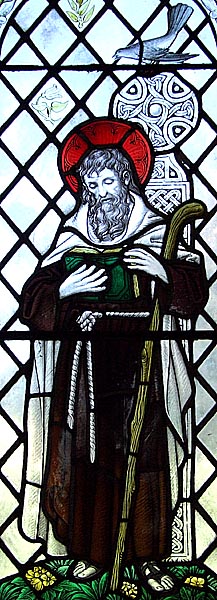 |
 |
|||
|
|
St. Brynach's background is shrowded in mystery. He is sometimes said to have been the son of a King of Calabria (in Italy), although this is unlikely. He was probably from Ireland since 'Bernach' is an Irish name and he is occasionally referred to as Brynach Wyddel (the Irishman). As a young man, he made a pilgrimage to Rome, where he defeated a ferocious serpent. Upon his return journey, he settled in Brittany, where he made efforts to evangelise the local population. He eventually moved on to Wales, floating on a stone (probably his portable altar) and landing at Milford Haven. He first travelled north-east to Llanboidy (Carmarthenshire) where he was denied lodgings by the locals and slept in a cow-shed. At Cilymaellwyd he recived the same treatment and was forced to shelter under a grey stone. Eventually he built himself a small hermitage at Llanfyrnach in Pembrokeshire. However, there he was the victim of a vicious spear attack by a woman whose advances he had rejected. Fortunately he was rescued by a passer-by and washed his wounds in a nearby well, thenceforth known as the 'Fons Rubeus'. Brynach found a new home at Pont-faen on the River Gwaun but was soon driven away by demons. At Llwyn Henllan on the River Nevern, he tried to build a church, but the locals stole all his wood. Then an angel appeared announcing that this latter place was not for him. So, Brynach moved on to Nevern on the banks of the little River Caman. He introduced agriculture to the people and taught them how to yoke wild stags to the plough and to milk the hinds. He also chopped wood from the trees and had these deer draw it to the place where he built a church on the site of the present one. The local king, Clether, was so impressed by Brynach and his rhetoric that he gave up his throne in order to retire to Kernow (Cornwall) as a Christian hermit. He gave Brynach all his lands and his twenty sons became his first disciples at the monastery which developed around his little church. He also founded the churches of Dinas and Newport (Pembrokeshire), near where he conversed with angels on Carningli. Brynach had a fine cow which gave so much milk that it sustained all his monks. It was looked after by his tame wolf. However, one day King Maelgwn Gwynedd and his retinue arrived at Brynach's monastery, demanding food and entertainment. When Brynach refused them, they killed the cow and butchered it ready for cooking. However, the water would not boil and the King perceived that God was intervening on Brynach's behalf. He immediately apologised and tried to make amends. The magnanimous Brynach restored the cow to life and miraculously produced a magnificent spread - plucking bread from the trees - that Maelgwn freed Nevern Abbey from all taxation. During his life at Nevern, he often moved around somewhat South Wales, founding churches as he went, including Llanfrynach in Brycheiniog and Llanfrynach and Penllin in Morgannwg. He became a great friend of St. Dewi who often visited him at Nevern. Once, Dewi arrived carrying a heavy highly-decorated stone cross-head. He was taking it to Llanddewi Brefi as a memorial to his achievements at the Synod held there in AD 545. However, Brynach persuaded Dewi to give it to him instead. He had an equally finely carved shaft made and mounted the cross on the top, installing it on the south side of Nevern Abbey Church. (The version there today is said to be a 10th century replacement). Eventually, St. Brynach left Wales to try his luck in Dumnonia. He lived as a hermit at Braunton (North Devon) and it was there that he died on 7th January (according to his West Country adherents) and was buried in his church there. In Wales, however, his feast day is 7th April perhaps because this was traditionally the day on which the first cuckoo in the country is said to sing every year from the top of St. Brynach's famous cross in Nevern churchyard. Records of St. Brynach date back to the 12th century. He could be historic.
|
|||
| © Nash Ford Publishing 2006. All Rights Reserved. | ||||





 St. Brynach
St. Brynach